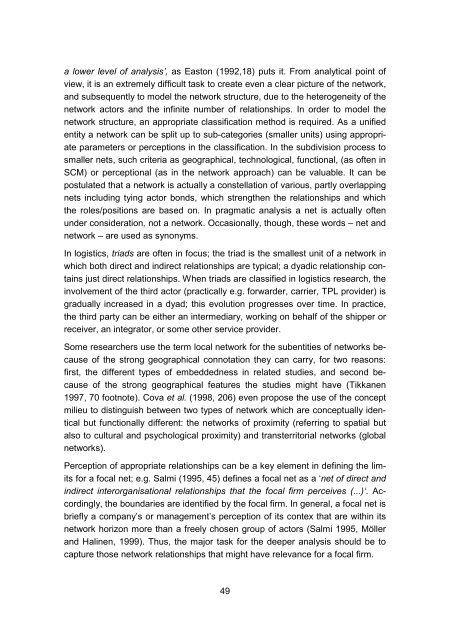849954 sisus
849954 sisus
849954 sisus
You also want an ePaper? Increase the reach of your titles
YUMPU automatically turns print PDFs into web optimized ePapers that Google loves.
a lower level of analysis’, as Easton (1992,18) puts it. From analytical point of<br />
view, it is an extremely difficult task to create even a clear picture of the network,<br />
and subsequently to model the network structure, due to the heterogeneity of the<br />
network actors and the infinite number of relationships. In order to model the<br />
network structure, an appropriate classification method is required. As a unified<br />
entity a network can be split up to sub-categories (smaller units) using appropriate<br />
parameters or perceptions in the classification. In the subdivision process to<br />
smaller nets, such criteria as geographical, technological, functional, (as often in<br />
SCM) or perceptional (as in the network approach) can be valuable. It can be<br />
postulated that a network is actually a constellation of various, partly overlapping<br />
nets including tying actor bonds, which strengthen the relationships and which<br />
the roles/positions are based on. In pragmatic analysis a net is actually often<br />
under consideration, not a network. Occasionally, though, these words – net and<br />
network – are used as synonyms.<br />
In logistics, triads are often in focus; the triad is the smallest unit of a network in<br />
which both direct and indirect relationships are typical; a dyadic relationship contains<br />
just direct relationships. When triads are classified in logistics research, the<br />
involvement of the third actor (practically e.g. forwarder, carrier, TPL provider) is<br />
gradually increased in a dyad; this evolution progresses over time. In practice,<br />
the third party can be either an intermediary, working on behalf of the shipper or<br />
receiver, an integrator, or some other service provider.<br />
Some researchers use the term local network for the subentities of networks because<br />
of the strong geographical connotation they can carry, for two reasons:<br />
first, the different types of embeddedness in related studies, and second because<br />
of the strong geographical features the studies might have (Tikkanen<br />
1997, 70 footnote). Cova et al. (1998, 206) even propose the use of the concept<br />
milieu to distinguish between two types of network which are conceptually identical<br />
but functionally different: the networks of proximity (referring to spatial but<br />
also to cultural and psychological proximity) and transterritorial networks (global<br />
networks).<br />
Perception of appropriate relationships can be a key element in defining the limits<br />
for a focal net; e.g. Salmi (1995, 45) defines a focal net as a ‘net of direct and<br />
indirect interorganisational relationships that the focal firm perceives (...)‘. Accordingly,<br />
the boundaries are identified by the focal firm. In general, a focal net is<br />
briefly a company’s or management’s perception of its contex that are within its<br />
network horizon more than a freely chosen group of actors (Salmi 1995, Möller<br />
and Halinen, 1999). Thus, the major task for the deeper analysis should be to<br />
capture those network relationships that might have relevance for a focal firm.<br />
49








